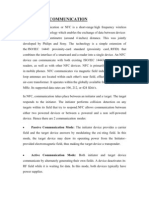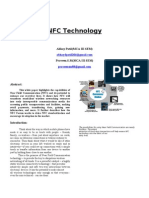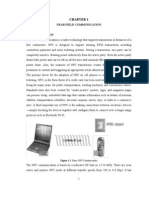Contactless Near Field Communication (NFC)
Contactless Near Field Communication (NFC)
Uploaded by
omarkaghaCopyright:
Available Formats
Contactless Near Field Communication (NFC)
Contactless Near Field Communication (NFC)
Uploaded by
omarkaghaOriginal Title
Copyright
Available Formats
Share this document
Did you find this document useful?
Is this content inappropriate?
Copyright:
Available Formats
Contactless Near Field Communication (NFC)
Contactless Near Field Communication (NFC)
Uploaded by
omarkaghaCopyright:
Available Formats
CONTACTLESS NEAR FIELD COMMUNICATION (NFC): An NFC device may make a payment like a credit card by touching a payment
terminal at checkout or a vending machine when a PIN is entered. Near Field Communication (NFC) is used mostly in paying for purchases made in physical stores or transportation services. A consumer using a special mobile phone equipped with a smartcard waves his/her phone near a reader module. Most transactions do not require authentication, but some require authentication using PIN, before transaction is completed. The payment could be deducted from a pre-paid account or charged to a mobile or bank account directly. The NFC mobile-payment application is currently in trials in the United States, Germany, Finland, the Netherlands and a few other countries, with transportation ticketing as a primary use (think SpeedPass on a cell phone). A mobile-payment-enabled phone is associated with a bank or credit-card company just like it's associated with a phone-service provider. The technology is similar to the RFID (radio frequency identification) transmitters used in contactless credit cards, except that NFC chips allow for two-way communication instead of only one way, which is supposed to make for a more secure payment method. NFC expands eCommerce opportunities, increases transaction speed and accuracy, while reducing staffing requirements. Mobile payment method via NFC faces significant challenges for wide and fast adoption, due to lack of supporting infrastructure, complex ecosystem of stakeholders, and standards. TECHNOLOGY: The technology behind NFC, like RFID, uses inductive coupling to transfer data. Induction occurs when a wire (or any other conductor of electricity) passes through a magnetic field, generating an electric current in the wire. It's similar to the principal of electromagnetism -- that passing an electric current through a coil of wire will generate a magnetic field -- only in reverse. An NFC chip has a coil of wire built into it, much like an RFID chip. When an NFC-equipped cell phone gets to within a few centimeters of an NFCequipped payment station, which is generating a magnetic field and also has a coil of wire inside, an electric current jumps between the two coils of wire, signaling data-carrying, short-range radio waves to pass between the two
devices. MARKETPLACE FOR NFC: According to a research two recent events have likely ushered the dawn of NFC smartphone technology in the mainstream marketplace. Google released Google Wallet Isis announced last week that a handful of major handset manufacturers are already showing support for its NFC platform. (Isis is a joint mobile payment venture between AT&T and Verizon and T-Mobile. ISIS now backed by four major Credit Cards, just announced partnerships with three new credit card companies: Visa, MasterCard and American Express. PayPal took its first step towards NFC adoption. It unveiled a service that allows Android users to transfer funds between NFC-enabled mobile devices, simply by tapping them together. The Nokia 6131 was the first fully integrated mobile-payment cell phone. APPLICATIONS: NFC vendors mostly in Europe use contactless payment over mobile phones to pay for on- and off-street parking in specially demarcated areas. The NFC chip is embedded underneath the cover of the phone. According to the NFC forum, you could also use an NFC phone to unlock the door to your house and synch your phone calendar with your PC calendar.
You might also like
- (G) New SAT Grammar Workbook (Advanced Practice) - (Student Book)Document99 pages(G) New SAT Grammar Workbook (Advanced Practice) - (Student Book)유시호90% (10)
- HS500 User Manual.V110.enDocument5 pagesHS500 User Manual.V110.enMohammed Qaid AlathwaryNo ratings yet
- History Introduction Architecture Application Potential Threats ConclusionDocument15 pagesHistory Introduction Architecture Application Potential Threats ConclusionShailesh JainNo ratings yet
- Near Field CommunicationDocument18 pagesNear Field CommunicationAdrianNo ratings yet
- Main Seminar DevDocument4 pagesMain Seminar DevGaurav RoxNo ratings yet
- NFC ShoppingDocument15 pagesNFC ShoppingMohamad AbdelnaserNo ratings yet
- Chapter 4 Transaction TechnologiesDocument25 pagesChapter 4 Transaction Technologieshagosabate9No ratings yet
- JETIR1704079Document5 pagesJETIR1704079Hakuna DasNo ratings yet
- Chapter 4 NFC 2017-18Document45 pagesChapter 4 NFC 2017-18MeNo ratings yet
- Near Field CommunicationDocument6 pagesNear Field CommunicationAmritha AlexNo ratings yet
- Near Field CommunicationDocument27 pagesNear Field CommunicationErnesto VargasNo ratings yet
- Near Field Communication (NFC) Technology: The Future Mobile Money Service For KenyaDocument11 pagesNear Field Communication (NFC) Technology: The Future Mobile Money Service For KenyaAakash SheelvantNo ratings yet
- Near Field Communications (NFC) : MIS News Item Article and SummaryDocument7 pagesNear Field Communications (NFC) : MIS News Item Article and SummaryZarak Ahmed AnsariNo ratings yet
- NFC-A Techno Commercial AppraisalDocument6 pagesNFC-A Techno Commercial AppraisalAakash SrivastavaNo ratings yet
- Near Field Communication: A Seminar Report OnDocument34 pagesNear Field Communication: A Seminar Report OnSonu LovesforuNo ratings yet
- NFC Ieee FormatDocument3 pagesNFC Ieee FormatChetan PatilNo ratings yet
- E WalletDocument20 pagesE WalletSumit KNo ratings yet
- M D NFC P A: Obile Evices Using IN Ayment PplicationsDocument5 pagesM D NFC P A: Obile Evices Using IN Ayment PplicationsAhmed adelNo ratings yet
- Overview of Mobile Payment Systems: Amit NaikDocument39 pagesOverview of Mobile Payment Systems: Amit NaikindicthreadsNo ratings yet
- Near Field Communicaiton: By-Neha SinghDocument22 pagesNear Field Communicaiton: By-Neha SinghmedNo ratings yet
- Near-Field Communication: Where Next?Document4 pagesNear-Field Communication: Where Next?Ralph AdamNo ratings yet
- NFC Technology in Public TransportDocument6 pagesNFC Technology in Public TransportAhmed adelNo ratings yet
- Near Field CommunicationDocument5 pagesNear Field CommunicationRohit GoelNo ratings yet
- Chaud Hari 2015Document4 pagesChaud Hari 2015 No ratings yet
- NFC Enabling Technology FinalDocument11 pagesNFC Enabling Technology FinalKunal KrishnaNo ratings yet
- Near Field CommunicationDocument5 pagesNear Field CommunicationRahul ManlyNo ratings yet
- Explanatory Speech OutlineDocument7 pagesExplanatory Speech OutlineewoijeiwNo ratings yet
- Near Field Communication (NFC) : APPLICATIONS:NFC Devices Can Be Used in ContactlessDocument2 pagesNear Field Communication (NFC) : APPLICATIONS:NFC Devices Can Be Used in ContactlessBhaskar Rao PNo ratings yet
- Seminar On NFCDocument42 pagesSeminar On NFCkebe AmanNo ratings yet
- Near Field Communication Technology: P.Vinod Kumar 08Q61A0456Document13 pagesNear Field Communication Technology: P.Vinod Kumar 08Q61A0456Vinod KumarNo ratings yet
- An Assessment of NFC For Future Mobile Payment SystemsDocument7 pagesAn Assessment of NFC For Future Mobile Payment Systemswoody woodpeckerNo ratings yet
- Digital Payments SADocument11 pagesDigital Payments SAishaNo ratings yet
- NFCDocument24 pagesNFCArjunkrishnanep Arjun100% (2)
- Nearfield Communications 183-C049Document4 pagesNearfield Communications 183-C049Ahmed adelNo ratings yet
- NFC and ShoppingDocument42 pagesNFC and ShoppingDigital Lab100% (8)
- PPTDocument24 pagesPPTPavan Smiley100% (1)
- Iot Applications On Smart Shopping Cart With Automatic BillingDocument4 pagesIot Applications On Smart Shopping Cart With Automatic BillingArthur AguilarNo ratings yet
- Near Field CommunicationDocument9 pagesNear Field CommunicationNIKHIL N KUMARNo ratings yet
- NFC in Smartphones BurkardDocument10 pagesNFC in Smartphones BurkardJohn AbrahimNo ratings yet
- M-Commerce: Presented By: Jan-e-Ali Nabi Junaid HemaniDocument22 pagesM-Commerce: Presented By: Jan-e-Ali Nabi Junaid Hemaniaskfor73No ratings yet
- Chapter 5 Emerging Technologies NFCs and IoTs 2019 G4Document40 pagesChapter 5 Emerging Technologies NFCs and IoTs 2019 G4SHIMELSNo ratings yet
- Seminar Report 2308211Document24 pagesSeminar Report 2308211Meenakshi DhasmanaNo ratings yet
- HANDYNFC Whitepaper en 101217, Property DataDocument12 pagesHANDYNFC Whitepaper en 101217, Property Datamarkus4463No ratings yet
- NFC PDFDocument4 pagesNFC PDFDestiny ConwayNo ratings yet
- Near Field CommunicationDocument1 pageNear Field CommunicationRupesh PatraNo ratings yet
- Newsletterelac20eng enDocument12 pagesNewsletterelac20eng enStartup AcademyNo ratings yet
- Secure Smartphone-Based NFC Payment To Prevent Man in The Middle AttackDocument5 pagesSecure Smartphone-Based NFC Payment To Prevent Man in The Middle AttackOldyson Tri AnggoroNo ratings yet
- Touch and Run With Near Field Communication (NFC)Document6 pagesTouch and Run With Near Field Communication (NFC)Chiranjivi KottamNo ratings yet
- Innovative Smart Car Parking System With NFC AccessDocument3 pagesInnovative Smart Car Parking System With NFC AccesserpublicationNo ratings yet
- Mobile TechnoloiesDocument30 pagesMobile TechnoloiesВиктори ЈаNo ratings yet
- Mobile Payment Based On RFID-SIM CardDocument3 pagesMobile Payment Based On RFID-SIM CardSubramanian SubbuNo ratings yet
- A Short Range Wireless Communication Using Android NFC APIDocument4 pagesA Short Range Wireless Communication Using Android NFC APIInternational Organization of Scientific Research (IOSR)No ratings yet
- NFCDocument21 pagesNFCnav1991navNo ratings yet
- Near-Field Communication - WikipediaDocument83 pagesNear-Field Communication - Wikipediaahmad.olukotunNo ratings yet
- English PresentationDocument4 pagesEnglish PresentationKabya Mithun SahaNo ratings yet
- Mobile CommerceDocument26 pagesMobile CommerceTamana AgrawalNo ratings yet
- Near Field Communication: TSKS03 Wireless System ReportDocument25 pagesNear Field Communication: TSKS03 Wireless System ReportabhinavdcNo ratings yet
- Near Field Communication (NFC) : What Does It Mean For Me?Document2 pagesNear Field Communication (NFC) : What Does It Mean For Me?supriyashwetaNo ratings yet
- (Near Field Communication) : Abbasali Kakal Manjyot Rait Stanford PintoDocument15 pages(Near Field Communication) : Abbasali Kakal Manjyot Rait Stanford PintoManjyot RaitNo ratings yet
- Near Field Communication (NFC) Is A Set of Standards ForDocument9 pagesNear Field Communication (NFC) Is A Set of Standards FortumishNo ratings yet
- Essentials of A Valid ContractDocument24 pagesEssentials of A Valid Contractomarkagha0% (1)
- Early Marriage NotesDocument1 pageEarly Marriage NotesomarkaghaNo ratings yet
- Garner Vs MurrayDocument2 pagesGarner Vs Murrayomarkagha50% (2)
- Mundell Flaming ModelDocument50 pagesMundell Flaming ModelomarkaghaNo ratings yet
- Fundamnetal Skills of Badminton Game HandoutsDocument61 pagesFundamnetal Skills of Badminton Game Handoutschristine booduanNo ratings yet
- 6 Minute English How The Language of Menus MattersDocument6 pages6 Minute English How The Language of Menus Mattersitsup2you.englishNo ratings yet
- Song Activity HappyDocument5 pagesSong Activity HappyNadiah Dwi NurhasanahNo ratings yet
- BIS List by UlquioraDocument15 pagesBIS List by UlquioraDiego Fernando Ramirez MuñozNo ratings yet
- LiabilityDocument1 pageLiabilityAmm AhNo ratings yet
- GFF - Battle Sisters v2.50Document2 pagesGFF - Battle Sisters v2.50Ruben MontenegroNo ratings yet
- Archery Facilities: Guidance & SpecificationsDocument40 pagesArchery Facilities: Guidance & SpecificationsExcel J FernandezNo ratings yet
- Price List - CompanyDocument28 pagesPrice List - Companyjuliematthews53No ratings yet
- Media 107107 enDocument196 pagesMedia 107107 enYusuf Wahyu ArdiantoNo ratings yet
- MKT 430 Termpaper-3Document32 pagesMKT 430 Termpaper-3Sakib RahmanNo ratings yet
- Times Leader 05-09-2011Document40 pagesTimes Leader 05-09-2011The Times LeaderNo ratings yet
- ASUS TX300CA-DH71 Ultrabook ManualDocument120 pagesASUS TX300CA-DH71 Ultrabook ManualRomeoNo ratings yet
- Trabajo Final de Conversacion Inglesa 1LDocument9 pagesTrabajo Final de Conversacion Inglesa 1Ljose limaNo ratings yet
- Regine Velasquez: The Asians Song BirdDocument9 pagesRegine Velasquez: The Asians Song BirdNeo127No ratings yet
- Liceo Faculty Wins 5 Awards in 1st Northern Mindanao Short-Film Festival - Liceo de Cagayan University - Film, Best, Cinema Gis, Short Film, AwardsDocument1 pageLiceo Faculty Wins 5 Awards in 1st Northern Mindanao Short-Film Festival - Liceo de Cagayan University - Film, Best, Cinema Gis, Short Film, AwardskickconassersNo ratings yet
- Musuem Case StudyDocument39 pagesMusuem Case Studykhushi agarwal100% (1)
- Chaplain DreadnoughtDocument1 pageChaplain Dreadnoughtinquisitor_beowulfNo ratings yet
- Clavinova en 2013 BrochureDocument22 pagesClavinova en 2013 BrochurepandayhhoNo ratings yet
- telangana traditional dress - Google SearchDocument1 pagetelangana traditional dress - Google Searchpfcz8trbdxNo ratings yet
- Playscript-Three Little PigDocument2 pagesPlayscript-Three Little PigCARMEN VILLARROEL LOPEZNo ratings yet
- Blue Fins WS1Document2 pagesBlue Fins WS1Paulo de CastroNo ratings yet
- 5 бжб 4 toksanDocument2 pages5 бжб 4 toksanЖанарыс БалтабаевNo ratings yet
- 1 - Aqueduct PPDocument26 pages1 - Aqueduct PPNico MuttachNo ratings yet
- 70-Masquerade Is OverDocument4 pages70-Masquerade Is Overizdr1No ratings yet
- PDF DocumentDocument1 pagePDF DocumentAsliNo ratings yet
- Why Now - by Lenny Rachitsky - Lenny's NewsletterDocument11 pagesWhy Now - by Lenny Rachitsky - Lenny's NewsletterjohnNo ratings yet
- Pokemon Unbound v1.1.3.1 (20 January 2021 Update) WalkthroughDocument253 pagesPokemon Unbound v1.1.3.1 (20 January 2021 Update) WalkthroughDuc Manh PhamNo ratings yet
- SRS Pattasu Kadai AllDocument2 pagesSRS Pattasu Kadai Allmanojkumar070902No ratings yet





























































































